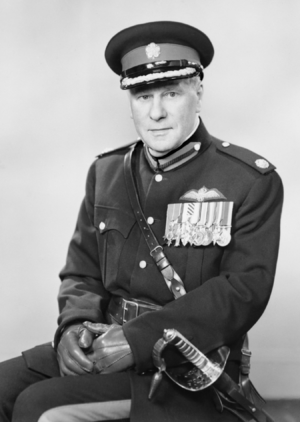Norman Macmillan (RAF officer) facts for kids
Quick facts for kids
Norman Macmillan
|
|
|---|---|
 |
|
| Born | 9 August 1892 Glasgow, Scotland |
| Died | 5 August 1976 (aged 83) |
| Allegiance | United Kingdom |
| Service/ |
British Army Royal Air Force |
| Rank | Wing Commander |
| Unit | Glasgow Highlanders No. 45 Squadron RFC |
| Battles/wars | World War I • Western Front World War II |
| Awards | Officer of the Order of the British Empire Military Cross Air Force Cross |
| Other work | Test pilot, author and Deputy Lieutenant |
Wing Commander Norman Macmillan was a brave Scottish pilot and writer. He was an officer in the Royal Air Force. During World War I, he became a flying ace, which means he shot down many enemy aircraft. After the war, he worked as a test pilot, trying out new planes. He also wrote many books about flying.
Contents
Biography
Early Life and Education
Norman Macmillan was born in Glasgow, Scotland, on August 9, 1892. His parents were John Campbell Macmillan and Jeanie Hamilton. He went to Allan Glen's School and the Royal Technical College for his education.
World War I Adventures
When World War I began in 1914, Norman Macmillan joined the army. He served as a private in the Glasgow Highlanders infantry unit. He spent over 16 months fighting in the trenches in Belgium and France.
Later, he joined the Royal Flying Corps, which was the air force at the time. He became a pilot and flew planes like the Sopwith 1½ Strutter and Sopwith Camel. Between June and October 1917, he became a flying ace by winning nine air battles. He was also promoted to captain.
In January 1918, a flying accident stopped him from fighting on the front lines. He then became a flying instructor in England. For his bravery, he received the Military Cross and the Air Force Cross.
Life After the War
After World War I, Norman Macmillan continued his career in aviation. He worked as a flying instructor for the Spanish Navy and Army Air Forces. He even saw action during the Rif War in Morocco.
Around-the-World Flight Attempt
In 1922, Macmillan tried to fly around the world with Major W T Blake and Geoffrey Malins. They started in London and planned to fly to Calcutta in a de Havilland DH.9 plane. The second part of their journey was from Calcutta to Vancouver. However, their Fairey IIIC floatplane was lost in the Bay of Bengal, and the trip ended. Macmillan later wrote about this adventure in his book, Freelance Pilot.
Test Pilot and Writer
During the 1920s, Macmillan became a test pilot. This meant he flew new aircraft to make sure they worked correctly and were safe. He flew planes for companies like Fairey Aviation and Parnall. In 1925, he became the chief test pilot for Fairey. He was even the first pilot to make an emergency landing at Heathrow, which is now a very famous airport!
Besides flying, Norman Macmillan was a talented writer. He wrote many articles for magazines and several books about aviation. He also wrote a detailed history of the Royal Air Force during World War II. During that war, he served as a war correspondent for the Royal Air Force.
Later Life and Achievements
Norman Macmillan continued to be involved in aviation throughout his life. He commanded the Cornwall Wing of the Air Training Corps for many years. He was also a founder of the Guild of Air Pilots and Air Navigators, an important group for pilots.
He achieved many impressive feats, including:
- Being the first pilot to fly from London to Sweden in one day.
- Winning an award at the first International Light Aeroplane meeting.
- Being the first British pilot to fly across the Andes mountains.
In 1951, he was appointed a Deputy Lieutenant for Cornwall. In 1956, he received the Order of the British Empire for his service.
In 1963, Macmillan was interviewed for a BBC documentary called The Great War. He shared his experiences flying during battles and what it was like to be a pilot compared to a soldier in the trenches.
Norman Macmillan was married to an actress named Gladys Mary Peterkin Mitchell, also known as "Pat."

